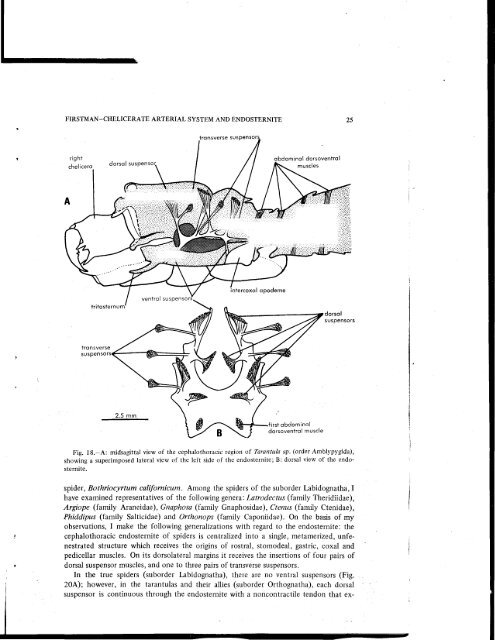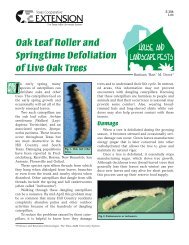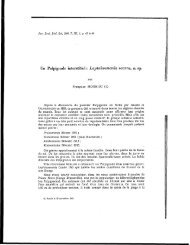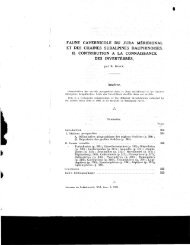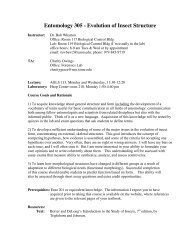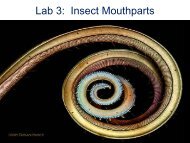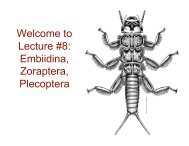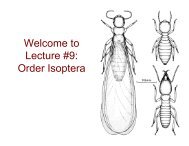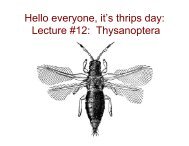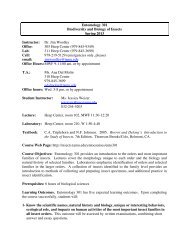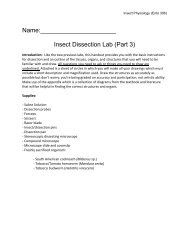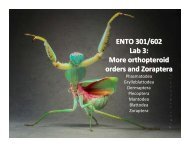24 <strong>THE</strong> JOURNAL <strong>OF</strong> ARACHNOLOGYThe earliest study of the schizomid arterial System is that of Börner (1904) whodescribed a heart with five pairs of ostia in Trithyreus cambridgei. I have examined T.pentapeltis, and I find that the arterial System conforms to the basic pattern which istypical of other pulmonate arachnids.A description of the endosternite of T. cambridgei was given by Börner (1904). Myown observations of T, pentapeltis confirm Bömer's findings. The schizomid endosterniteis morphologically very similar to that of a thelyphonid, except that it lacks the middlebridge and accordingly has only one central fenestra. There are four pairs of dorsalsuspensors which are matched below by four pairs of ventral suspensors (Fig. 17). Thehistological continuity of these dorsoventral muscles through the endosternite is readilyapparent, even by gross observation: it can be seen clearly that the dorsal and ventralsuspensors are continuous with each other by a tendinous tract of connective tissue fiberswhich passes vertically through the endosternite. A transverse muscle passes horizontallythrough the endosternite immediately behind the second dorsoventral suspensors, and atright angles to them (Fig. 17B). The right and left extremities of this muscle, whichoriginale from the lateral margins of the carapace, are continuous with each other by atendinous bar which constitutes the anterior cross-bridge (Börner's "verdereQuerbrücke") of the endosternite of Trithyreus.Order Amblypygida—The circulatory system of amblypygids has been described byBlanchard (1852) in Tarantula palmata. The arterial System conforms to the basic patternfor pulmonate arachnids. The endosternite has been described by Börner (l904) inT. palmata, and by Millot (1949d) in Dämon medius. I have examined the endosterniteof Tarantula sp, from Costa Rica. Its endosternite (Fig. 18), while bearing certain resemblancesto that of thelyphonids, is shaped more like that of an orthognath spider. It hasfour pairs of dorsal suspensors and three pairs of transverse suspensors. On the ventralside, there are two pairs of non-contractile tendinous processes which represent the firstand fourth ventral suspensors (i.e., they match the first and fourth dorsal suspensors).According to Millot (1949d, Fig. 325) in the endosternite of Dämon medius thefirst pair of ventral suspensors are contractile. As in thelyphonids, the endosternite extendsposteriad to the second abdominal segment. However, it lacks the anterior andmiddle bridges, and accordingly it has no fenestrations; in this way, it resembles thecephlothoracic endosternite of spiders.Order Araneida—Except for lungless spiders, the circulatory System of spiders correspondsto the basic pattern depicted in Fig. 19: a paired anterior aorta gives rise to apaired thoracic sinus which lies on top of the subesophageal ganglionic mass. Appendiculararteries arise from the sinus on each side, and a series of circumneural arteriessurrounds the central nervous System. An unpaired abdominal artery extends posteriadfrom the thoracic sinus. All of this has been described and illustrated by Schneider(1892) in Tegenaria, and in various other genera by Causard (1896). As in all nonscorpionpulmonate arachnids, there is no apparent morphological continuity of the arterialSystem with the endosternite.An-endosternite is universally present in spiders (Comstock, 1948), although there isvariety in its shape and relative size throughout the order. I have studied the endosternitesof various spiders: among those of the suborder Orthognatha, I have examinedthe brown tarantula, Eurypelma californicum (cf. Firstman, 1954), and the trapdoor
FIRSTMAN-<strong>CHELICERATE</strong> <strong>ARTERIAL</strong> <strong>SYSTEM</strong> AND ENDOSTERNITE25transverse suspensorsrightcheliceraabdominal dorsoventralmusclesp dorsalsuspensorsfirst abdominaldorsoventral muscleFig. 18.—A: midsagittal view of the cephalothoracic region of Tarantula sp. (order Amblypygida),showing a superimposed lateral view of the left side of the endosternite; B: dorsal view of the endosternite.spider, Bothriocyrtum califomicum. Among the spiders of the suborder Labidognatha, Ihave examined representatives of the following genera: Latrodectus (family Theridiidae),Argiope (family Araneidae), Gnaphosa (family Gnaphosidae), Ctenus (family Ctenidae),Phiddipus (family Salticidae) and Orthonops (family Caponiidae). On the basis of myobservations, I make the following generalizations with regard to the endosternite: thecephalothoracic endosternite of spiders is centralized into a single, metamerized, unfenestratedstructure which receives the origins of rostral, stomodeal, gastric, coxal andpedicellar muscles. On its dorsolateral margins it receives the insertions of four pairs ofdorsal suspensor muscles, and one to three pairs of transverse suspensors.In the true spiders (suborder Labidognatha), there are no ventral suspensors (Fig.20A); however, in the tarantulas and their allies (suborder Orthognatha), each dorsalsuspensor is continuous through the endosternite with a noncontractile tendon that ex-


